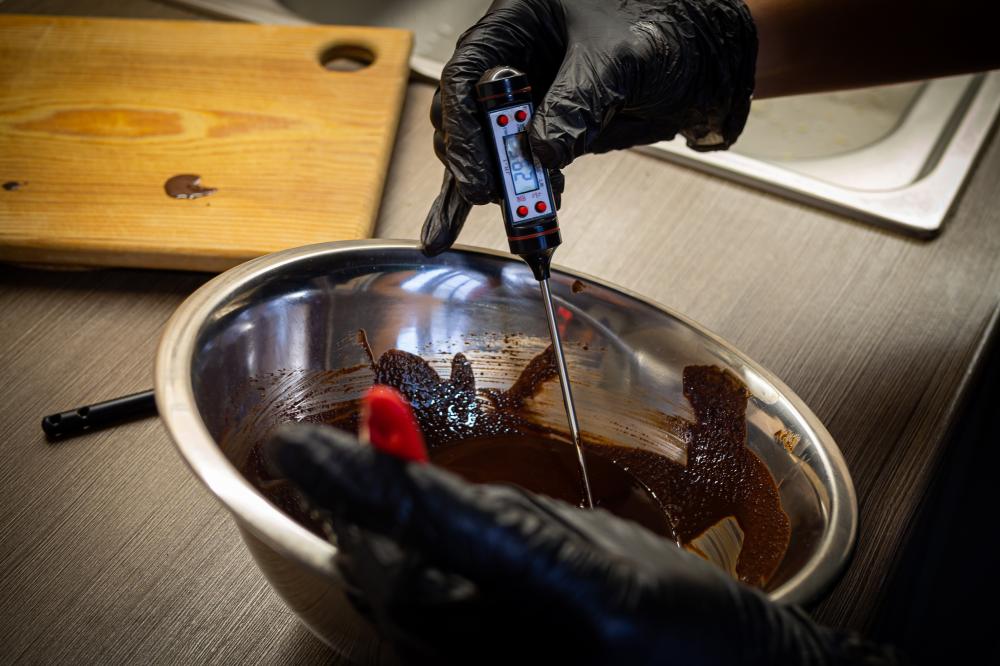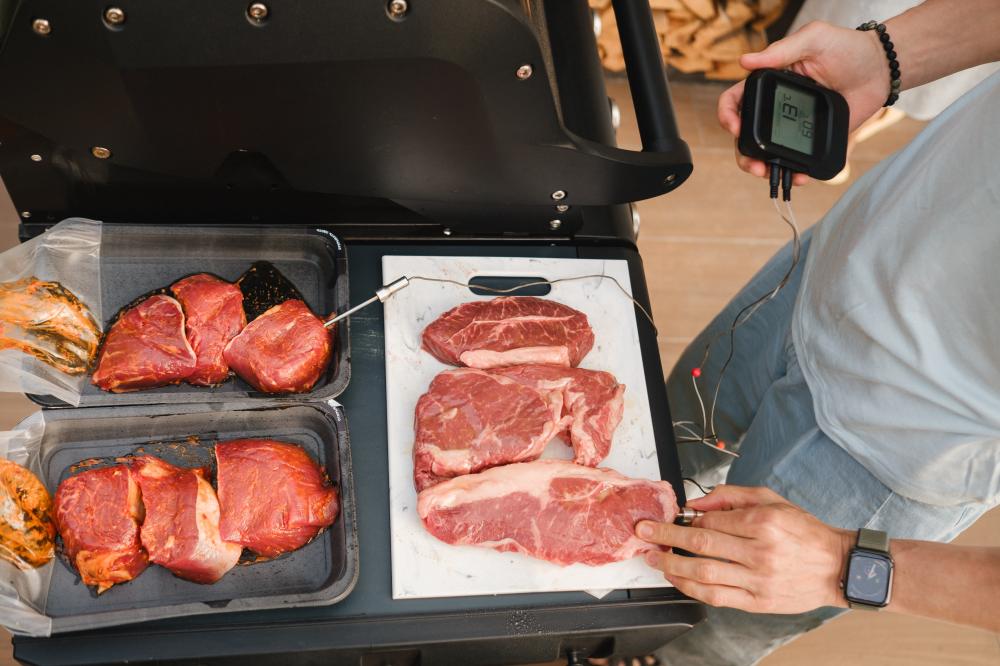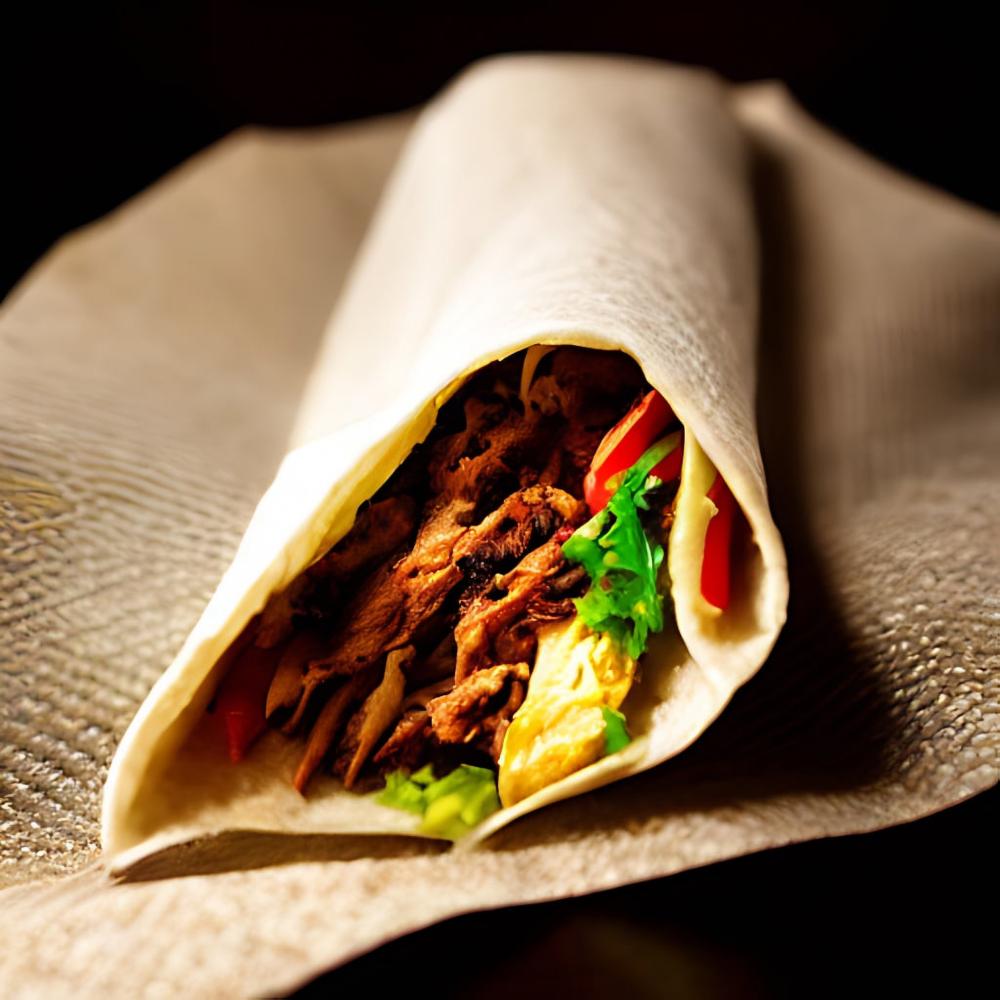
Understanding Brisket Internal Temp
At Brisket Pro, we often emphasize that achieving the perfect brisket is part art, part science. A pivotal aspect of this culinary science is understanding the brisket internal temp. The internal temperature of a brisket is essentially the thermometer to its soul, revealing when it’s perfectly cooked or when it needs more time on the grill. Let’s dive deep into why brisket internal temp is a topic of paramount importance for brisket aficionados.
When we speak of brisket internal temp, we’re targeting a sweet spot – a range where the tough connective tissues break down into gelatin, bathing each fiber of meat in mouthwatering moisture and flavor. This magical transformation typically occurs around 195°F (about 90°C). However, the journey to this temperature is where patience and precision play critical roles. Achieving and maintaining the right brisket internal temp without overshooting the mark demands vigilance and a good meat thermometer.
Cooking brisket is not a set-it-and-forget-it endeavor. The stall, a period during which the brisket’s internal temp plateaus due to evaporative cooling, is a test of a pitmaster’s resolve. It’s when the brisket is wrapped to conserve moisture and gently nudged through this temperature purgatory. This process, often mystifying to the novice, is second nature to the seasoned grill master. It underscores the importance of not solely relying on time but being guided by temperature and texture.
Tips for Monitoring Brisket Internal Temp
Keeping a close eye on your brisket’s internal temperature requires more than an occasional glance. Here are a few pro tips:
- Invest in a high-quality meat thermometer. Whether you prefer a digital instant-read or a leave-in probe, ensure it’s calibrated for accuracy.
- Check the temp in multiple spots. Given brisket’s varying thickness, probing in several locations ensures you’re not under or overcooking certain sections.
- Resist the urge to constantly open the smoker. Each peek can drastically lower the internal environment’s temp, extending your cook time unnecessarily.
Remember, the brisket internal temp is your roadmap to deliciousness. It’s not just about hitting a number but understanding what that number means for texture, moisture, and flavor.
Achieving Perfection
Through my years at the helm of Brisket Pro, I’ve witnessed many aspiring brisket masters focus solely on brisket internal temp as a beacon to the promised land of perfect barbecue. While it is undeniably important, I encourage a holistic approach. Consider the brisket internal temp as a critical component, but not the sole determinant of doneness. The ‘probe test,’ feeling for when a thermometer or skewer slides into the meat like butter, is equally telling. This tactile feedback, combined with a precise brisket internal temp reading, can elevate your brisket from merely good to transcendently great.
Another facet often overlooked is the rest period after reaching the target brisket internal temp. Resting allows juices to redistribute, ensuring that each slice is as succulent as possible. While it’s tempting to slice into that beautiful brisket right away, patience during the rest phase is a virtue that pays dividends in texture and flavor.
Lastly, don’t be disheartened by minor setbacks. The journey to brisket mastery is fraught with dry ends and tough middles. Each brisket is a learning opportunity, guiding you closer to achieving that melt-in-your-mouth masterpiece. Remember, the brisket internal temp is a guide, not an absolute. The true measure is in the smiles and satisfied sighs of those who partake in your barbecue.
Beyond the Thermometer
At Brisket Pro, we’ve always held that brisket is more than just a dish; it’s a culture, a way of life. Knowing your brisket internal temp is crucial, but integrating this knowledge into the broader tapestry of BBQ traditions, techniques, and innovations is what sets you apart. It’s the difference between painting by numbers and creating a masterpiece.
Marrying the science of brisket internal temp with the art of smoking yields results that are as satisfying to the soul as they are to the palate. In this realm, every brisket tells a story–a narrative woven from patience, passion, and perseverance. As you pursue the perfect brisket, let brisket internal temp be your guide but let your instincts, honed by experience and emboldened by creativity, lead the way.

Understanding Brisket Stall Temperature
Anyone who’s ever embarked on the journey to perfect their brisket has encountered the notorious phenomenon known as the “stall.” At Brisket Pro, we’ve delved deep into the science and sorcery of smoking brisket, where the brisket stall temperature plays a critical role. This temperature, typically around 165-170°F, is where the magic of patience meets the hard truth of physics. But what exactly happens when brisket hits this critical range?
The stall is primarily a cooling process, where evaporative cooling from the meat’s surface counteracts the heat of your smoker. Imagine the brisket sweating in the heat, much like you would on a hot summer day. This natural cooling effect is essential for slowly rendering fat and connective tissues, which contribute to the brisket’s succulence. However, it’s also the point where time seems to stand still, and the internal temperature of your brisket refuses to rise for what feels like an eternity.
To the uninitiated, this can be a moment of panic. However, at Brisket Pro, we see the stall as an opportunity. It’s a signal to reassess your cooking strategy, whether it’s wrapping the brisket to push through the stall or adjusting your smoker’s humidity to manage the evaporative cooling effect. Each brisket is a unique challenge, and mastering the stall is a badge of honor among BBQ enthusiasts.
Tackling the Stall
Wrapping Techniques
One widely adopted strategy to combat the brisket stall temperature is wrapping. Whether in aluminum foil or butcher paper, wrapping acts as a shield, minimizing moisture loss and accelerating the cooking process past the stall. Foil is particularly effective for beginners due to its convenience and the tight seal it provides. Butcher paper, on the other hand, offers a compromise, allowing the brisket to breathe and continue taking on smoke, while still pushing through the stall.
Choosing to wrap your brisket is a nuanced decision. It hinges on your personal preference for the bark’s texture and the overall moisture content of the meat. It’s a spirited dance with heat, moisture, and time, and getting it right can feel like a triumph.
Managing the Smoke
Another essential aspect of navigating the brisket stall temperature is managing the smoke. The initial hours of smoking are crucial for flavor development, with the brisket absorbing the majority of its smoky character. Post-stall, the focus shifts towards gently coaxing the brisket to its final, tender state. Here, the art of smoking intertwines with the science of heat management, and understanding when to introduce more smoke or when to let the brisket bathe in its own juices can make or break the final outcome.
Personal anecdotes from our BBQ community highlight the variety of approaches to the stall. Some swear by a meticulous monitoring of smoker temperature and humidity levels, while others recount tales of leaving the brisket to its own devices, wrapped snugly in butcher paper. Each brisket tells a story, not just of the meat itself, but of the patience, adjustments, and occasional frustrations that culminate in a delectable masterpiece.
Embracing the Stall
At Brisket Pro, we view the brisket stall temperature not as an obstacle, but as an integral part of the brisket’s journey to perfection. Embracing the stall means respecting the process, understanding that good things come to those who wait–and sometimes, those who wait while actively managing their smoker. Whether you’re a seasoned pitmaster or a brisket newbie, navigating the stall is a rite of passage that deepens your connection to the art of BBQ.
To our fellow brisket aficionados, we offer this advice: respect the stall, understand its causes, and use it as a guidepost for managing your cook. Whether you’re wrapping, adjusting temperatures, or experimenting with humidity levels, remember that each brisket offers a new lesson in patience, technique, and flavor development.
In the end, the brisket stall temperature is more than just a number on a thermometer–it’s a benchmark for understanding how heat, moisture, and time fuse to create something truly extraordinary. At Brisket Pro, we cherish these moments of culinary alchemy, and we invite you to share in the joy and challenge of mastering the brisket stall.
When to Wrap Brisket
As a pioneer in the brisket knowledge domain, we often encounter the question: When to wrap brisket? It’s a pivotal moment in the cooking process that can drastically affect the outcome. The consensus among brisket aficionados, including myself, is to wrap the brisket when its internal temperature reaches 165-170°F. This technique, known affectionately as “The Texas Crutch,” serves a multitude of purposes, from hastening the cooking time to ensuring a moist, delectable finish.
Wrapping brisket is not just a step in the cooking process; it’s an art form perfected by those who treasure the balance between bark perfection and juicy tenderness. From personal experience and countless brisket endeavors, wrapping at the right moment has always been the bridge between a good brisket and a great one.
Why Wrap Brisket?
Faster Cooking Time
One does not simply cook a brisket; they embark on a journey. Yet, the journey’s length can be daunting, especially when faced with ‘the stall.’ Wrapping your brisket combats this by trapping the heat and moisture, effectively breaking the standoff between evaporative cooling and the smoker’s heat. I’ve found through trial and error that wrapping can shave hours off the cooking time without sacrificing the meat’s flavor.
Control Over the Bark and Juiciness
The bark is the brisket’s crowning glory, a testament to hours of patient smoking. By choosing when to wrap your brisket, you maintain control over the bark’s development–wrap too soon, and you may sacrifice some of that coveted texture; too late, and the outer layers might dry out. In my culinary adventures, I’ve discovered that wrapping the brisket at the recommended internal temperature provides the perfect balance, preserving the bark’s integrity while ensuring the meat remains succulent.
Moreover, the juices that would otherwise evaporate are locked in by the wrap, basting the brisket in its flavors and contributing to an unforgettable mouthfeel. This is particularly noticeable in the moments when the brisket continues to cook within its cozy foil or butcher paper envelope.
Choosing Your Wrapping Material
Aluminum Foil vs Butcher Paper
In the realm of brisket wrapping, two champions emerge: aluminum foil and butcher paper. Each brings its benefits and nuances to the table. Foil, for instance, offers a tighter seal, propelling the brisket through the stall with remarkable efficiency. However, it comes at the cost of potentially softening the bark due to condensation. Butcher paper, on the other hand, is the choice of purists seeking to marry the brisket’s innate flavors with a hint of smokiness, allowing for breathability while still promoting a quicker cooking time.
- Aluminum Foil: Ideal for beginners and those favoring convenience. It ensures moisture retention and a faster cook.
- Butcher Paper: Celebrated for its ability to enhance flavor while still cutting down the stall time, though it requires a bit more finesse to use effectively.
In our journey at Brisket Pro, both materials have their moment in the spotlight, depending on the desired outcome. It’s a choice that reflects not just your preference for texture and flavor, but also the story you wish to tell through your brisket.
Deciding when to wrap brisket is a crucial step in the cooking process, profoundly impacting the final product. Guided by internal temperature and personal preference, this decision weaves together science, art, and tradition. Whether using aluminum foil or butcher paper, the key is understanding the nuanced effects of each, ensuring your brisket remains a testament to your dedication and love for barbecue.

Is brisket done at 190 or 200?
At Brisket Pro, this question sparks quite the conversation. You see, brisket done-ness is not a precise science but rather, a delicate balance that hinges on temperature and texture. Generally, briskets are considered done when their internal temp reaches anywhere between 190°F and 205°F. However, deciding whether to pull your brisket at 190°F or wait until it hits 200°F depends on several factors including your personal preference for tenderness and moisture.
Personally, I’ve found that pulling a brisket closer to 200°F often results in that fall-apart tenderness that many of us BBQ aficionados chase after. Yet, I’ve also encountered briskets that felt perfectly succulent at slightly lower temps. It’s a testament to the variable nature of each brisket cut and the importance of not just relying on temperature but also on the ‘feel’ of the meat, such as the ease of a probe insertion.
You might now wonder, how do you decide for your next cook? My advice: aim for a range, not an absolute. Start checking for tenderness as you approach 190°F and let your instincts guide you from there. Remember, each brisket tells its own story.
What temp do you pull brisket?
Pulling a brisket off the smoker is a moment of triumph, one that’s often met with anticipation and, let’s be honest, a bit of relief. I recommend pulling your brisket when it reaches an internal temperature of around 195°F to 205°F. This range is widely regarded as the sweet spot for achieving a brisket that’s not just cooked, but artfully rendered tender and flavorful.
That said, temperature is just part of the equation. The ‘probe test,’ where a meat probe slides into the brisket like butter, is equally crucial. It provides a direct insight into the meat’s tenderness beyond what any thermometer can tell you.
In my years behind the smoker, I’ve learned that flexibility and attentiveness to both temperature and texture are your best tools. And remember, each brisket might behave a bit differently based on its size, fat content, and even the type of smoker you’re using, so adaptability is key.
Is brisket done at 180?
If pulled at 180°F, most briskets would likely be underdone. Typically, brisket requires an internal temp of 195°F to 205°F to fully break down the tough connective tissues into gelatinous, flavorful goodness. At 180°F, the brisket is on its journey, nearing the stall but not quite past it to where the magic of tenderness and flavor happens.
It’s crucial to remember, brisket is a marathon, not a sprint. Rushing to the finish line can result in a tough and chewy experience, far from the melt-in-your-mouth texture you’re aiming for. So, patience is truly a virtue in brisket cooking. Waiting for the internal temp to rise post-stall will reward you with a much more satisfying result.
Consider this: have you ever found yourself wondering if just a few degrees could really make a difference? In brisket smoking, it absolutely does. Each degree is a step towards perfection.
Why does brisket need to be 205?
Targeting a brisket internal temp of 205°F is often viewed as the gold standard for achieving optimal tenderness. But why this specific temperature? It’s all about the breakdown of connective tissues and collagen within the brisket. At around 205°F, these components have sufficiently melted, transforming into gelatin that imbues the meat with moisture and gives it that coveted pull-apart texture.
However, it’s important to underscore that not every brisket must reach exactly 205°F to be considered done. Some may be perfectly tender at a slightly lower temp. The emphasis on 205°F comes from it being a reliable indicator that the brisket has undergone the necessary transformation. Yet, this doesn’t sideline the importance of texture checks like the ‘probe test.’
In my brisket journey, treating 205°F as a guideline rather than a strict rule has led to some of my most memorable cooks. It’s about marrying the science of temperature with the art of feeling and observation. How do you find this balancing act in your own smoking adventures?
Resources
- Food Safety and Inspection Service (FSIS) – The FSIS website provides valuable information on food safety, including proper cooking temperatures for various meats.
- Smoking Meat Forums – A community of experienced smokers sharing tips, tricks, and advice on smoking brisket and other meats.
- Certified Angus Beef – A trusted source for information on beef cuts, cooking techniques, and recipes, including brisket preparation.
- National Pork Board – While focused on pork, this site offers insights into meat cooking methods and temperature guidelines that can be applied to brisket.

